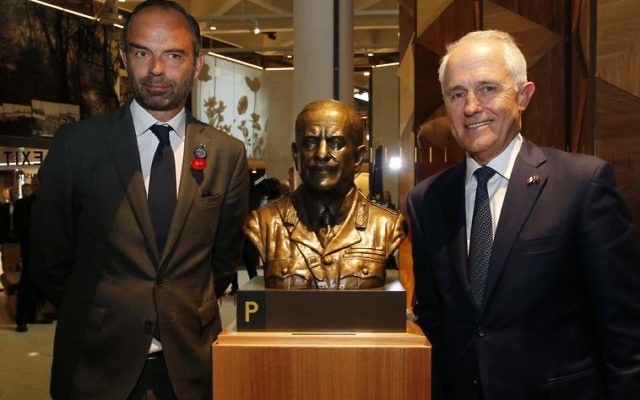‘Our greatest general’
OPENING the new Sir John Monash Centre in northern France on April 24, Prime Minister Malcolm Turnbull paid tribute to Australia's greatest citizen soldier and to the 11,000 Diggers who fell in France during World War I and have no graves.

OPENING the new Sir John Monash Centre in northern France last Wednesday, Prime Minister Malcolm Turnbull paid tribute to Australia’s greatest citizen soldier – referencing his Jewish heritage – and to the 11,000 Diggers who fell in France during World War I and have no graves.
The museum at Villers- Bretonneux, commissioned by former PM Tony Abbott, tells how the tide turned in the Allies’ favour during 1918 under General Sir John Monash’s command.
Villers-Bretonneux had been seized by the Germans during their massive spring offensive on the Western Front as part of their plan to drive the Allies into the sea and win the war.
Monash’s ingenuity in forging infantry, artillery and tank power into a style of modern armoured warfare enabled the Allies to lib- erate Hamel, preventing the Germans from reaching the stra- tegic city of Amiens, which led to their defeat in the war.
The $100 million museum was opened on the centenary of the Villers-Bretonneux battle fought on April 24-25, 1918, the third anniversary of the Anzacs’ Gallipoli landings.
Turnbull told his audience of dignitaries from the Australian and French parliaments and armed forces that Monash “revolutionised warfare on the Western Front”.
“Monash led Australian and American infantry in what was then the most sophisticated joint opera- tion in history involving air drops, artillery and a line of British tanks in the battle of Hamel,” he said.
“That victory put the German army on the defensive right up until Armistice Day.
“That’s why we are naming this centre after Sir John Monash – but it is a memorial to all the Australians who served in this terrible war – from the private soldiers like my grandfather Fred Turnbull, to our greatest general,” he said.
“Before Monash boarded his transport ship in December 1914, he and 80 other Jewish military men crowded into the St Kilda Synagogue. Monash opened the ark to bring out the Torah scroll and the young Rabbi Jacob Danglow told the congregation: ‘Against the shadow of the darkest calamity which has ever befallen this world, there is a just God judging in the world.’”
Describing the battlefield knighthood bestowed by King George V on Monash – “the son of Prussian Jewish immigrants” – as “the episode which perhaps struck
the most”, French PM Edouard Philippe compared him to leg- endary 16th century French war- rior Chevalier Bayard honoured by King Francis I after a battle as “the knight beyond fear and without reproach”. Monash, said Philippe, was “Bayard of the bush”.
Last month, Turnbull rejected calls to elevate Monash to the rank of field marshal, based on an Australian Defence Forces principle not to award posthumous promotions in rank.
PETER KOHN

comments